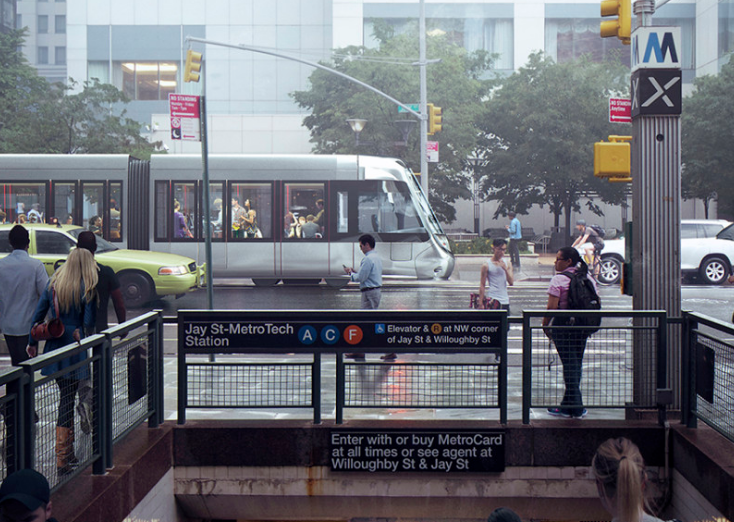EDC: LOL, BQX Not DOA, OK?
Even after the city named 21st Street a "Vision Zero priority corridor," the mayor is still pushing for a trolley.

- Sorry, Queens activists: The BQX trolley ain’t dead yet.
Several street safety leaders in the largest borough were crowing last week when the mayor named 21st Street as a “Vision Zero priority corridor” — believing that the roadway’s inclusion in a crucial street safety program would make it impossible for the Economic Development Corporation to pursue its plans for an at-grade streetcar along the same roadway.
But city officials said the BQX is still a go.
“The BQX will link long-disconnected neighborhoods and shorten commutes for over half a million New Yorkers who live and work along the Brooklyn and Queens waterfront,” said EDC spokeswoman Stephanie Baez. “It is a 21st-century solution to our city’s transit challenges and we’re excited to move the project forward.”
She added that the agency expects to begin working on the Environmental Impact Statement this spring.
That countered some activists’ belief that the BQX was incompatible with the city’s pedestrian safety efforts.
“For over three years, @nyc_dot stalled and refused to take action on #Fix21stSt because the BQX might be coming,” then-Transportation Alternatives Queens Committee Chairman Macartney Morris tweeted after the announcement that the roadway between 20th and 50th avenues had been added to the Vision Zero priority list. “It should be clear that BQX is officially dead.”
Morris was clearly hoping that the installation of safety measures, which include pedestrian head-starts at intersections, signal re-timing to slow down drivers, speed bumps and cushions, stepped-up enforcement, a possible bike lane and other engineering improvements, would block the BQX, also known as the Brooklyn-Queens Connector.
A spokesman for the Department of Transportation, echoed the EDC’s commitment to the BQX, adding that safety and the BQX could go hand-in-hand.
“Safety improvements and the BQX do not rule each out,” said Scott Gastel. “The BQX would have a traffic-calming impact in many areas, thereby positively impacting pedestrian safety.”
It is not clear if Gastel is right. Very few academic studies have been done about the safety of at-grade trolley systems or trams. The ones that have been done have raised some red flags.
“Tram systems have number of attractive features including their high passenger capacity, good comfort, and very low emission of pollutants compared to other transport systems,” researchers at Monash University wrote in an Australian study in 2015. “However, trams present a range of inherent safety issues regarding their design and operational characteristics, since they are large and heavy vehicles operating in confined, mixed and complex environments with pedestrians and cars, and even at low speed trams have been identified to have high crash risks compared to other vehicles. Previous studies have also identified that trams impose more crash risks at intersections and along arterials than buses, and this is likely due to difference in operational methods between buses and trams.”
Safety improvements are certainly crucial along 21st Street, as both DOT and Transportation Alternatives have concluded. According to city statistics, the 3.6-mile corridor had an average of 4.2 pedestrians killed or seriously injured per year between 2012-2016, up 50 percent from 2.8 pedestrians killed or seriously injured between 2009-2013.
Overall, last year, there were 94 reported crashes along 21st Street between 20th Avenue and the Queensboro Bridge, with nine cyclists and 23 pedestrians injured. From 2012-2018, there were 528 reported crashes, killing three pedestrians, and injuring 54 cyclists and 179 pedestrians.
https://twitter.com/macartney/status/1098327221675134976
Regardless of its potentially positive impact on safety, the BQX remains a hugely controversial venture from the de Blasio administration. Its price tag alone — $2.7 billion to build — raises eyebrows among city planners. And many trolleygaggers have pointed out that a dedicated bus route — also known as bus rapid transit — could accomplish much of the same goals with less construction costs. The BQX would make its Astoria-to-Gowanus run on city streets with very little, if any, dedicated lanes, putting it in traffic with cars.
Last year, the city cut Sunset Park out of the route. And the mayor originally said the streetcar would pay for itself in the form of higher property values along its route — but City Hall has now said about $1.4 billion would be generated for the trolley.





